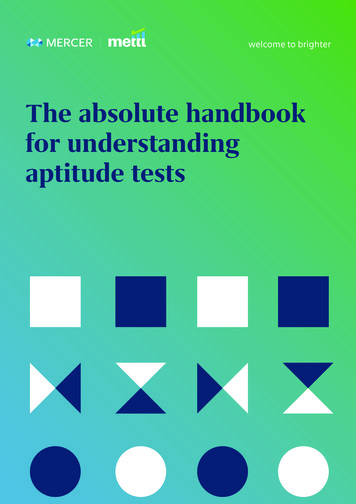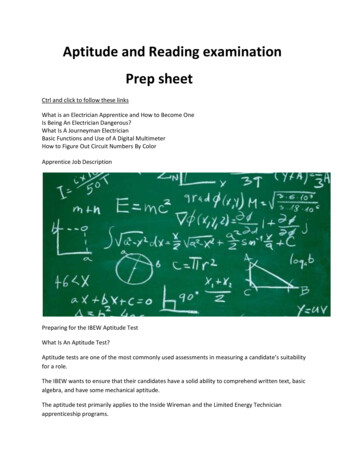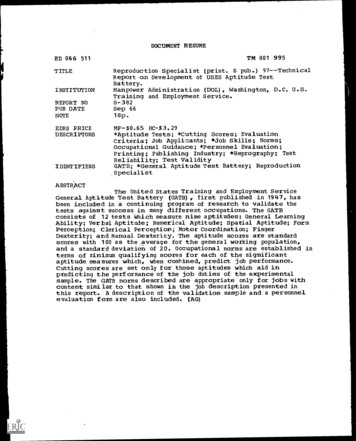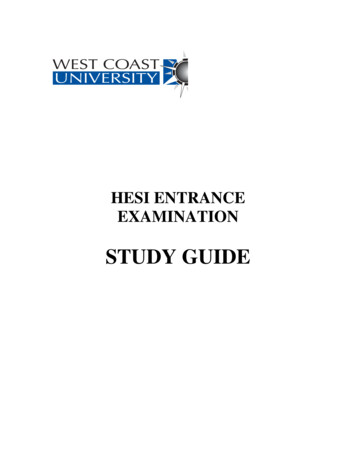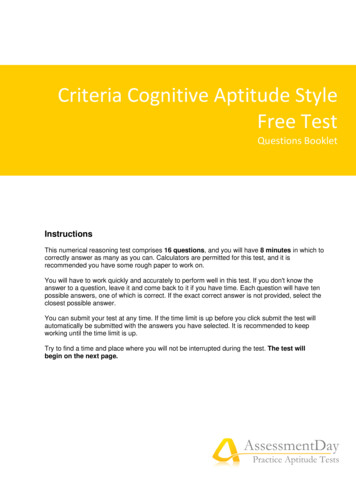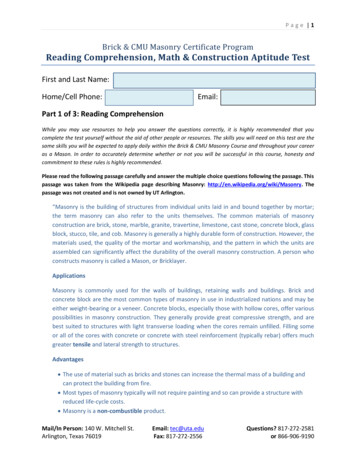
Transcription
Page 1Brick & CMU Masonry Certificate ProgramReading Comprehension, Math & Construction Aptitude TestFirst and Last Name:Home/Cell Phone:Email:Part 1 of 3: Reading ComprehensionWhile you may use resources to help you answer the questions correctly, it is highly recommended that youcomplete the test yourself without the aid of other people or resources. The skills you will need on this test are thesame skills you will be expected to apply daily within the Brick & CMU Masonry Course and throughout your careeras a Mason. In order to accurately determine whether or not you will be successful in this course, honesty andcommitment to these rules is highly recommended.Please read the following passage carefully and answer the multiple choice questions following the passage. Thispassage was taken from the Wikipedia page describing Masonry: http://en.wikipedia.org/wiki/Masonry. Thepassage was not created and is not owned by UT Arlington.“Masonry is the building of structures from individual units laid in and bound together by mortar;the term masonry can also refer to the units themselves. The common materials of masonryconstruction are brick, stone, marble, granite, travertine, limestone, cast stone, concrete block, glassblock, stucco, tile, and cob. Masonry is generally a highly durable form of construction. However, thematerials used, the quality of the mortar and workmanship, and the pattern in which the units areassembled can significantly affect the durability of the overall masonry construction. A person whoconstructs masonry is called a Mason, or Bricklayer.ApplicationsMasonry is commonly used for the walls of buildings, retaining walls and buildings. Brick andconcrete block are the most common types of masonry in use in industrialized nations and may beeither weight-bearing or a veneer. Concrete blocks, especially those with hollow cores, offer variouspossibilities in masonry construction. They generally provide great compressive strength, and arebest suited to structures with light transverse loading when the cores remain unfilled. Filling someor all of the cores with concrete or concrete with steel reinforcement (typically rebar) offers muchgreater tensile and lateral strength to structures.Advantages The use of material such as bricks and stones can increase the thermal mass of a building andcan protect the building from fire. Most types of masonry typically will not require painting and so can provide a structure withreduced life-cycle costs. Masonry is a non-combustible product.Mail/In Person: 140 W. Mitchell St.Arlington, Texas 76019Email: tec@uta.eduFax: 817-272-2556Questions? 817-272-2581or 866-906-9190
Page 2 Masonry walls are more resistant to projectiles, such as debris from hurricanes or tornadoes. Masonry structures built in compression preferably with lime mortar can have a useful life ofmore than 500 years as compared to 30 to 100 for structures of steel or reinforced concrete.Disadvantages Extreme weather, under certain circumstances, can cause degradation of masonry wall surfacesdue to frost damage. Masonry tends to be heavy and must be built upon a strong foundation, such as reinforcedconcrete, to avoid settling and cracking. Other than concrete, masonry construction does not lend itself well to mechanization, andrequires more skilled labor than stick-framing.Structural LimitationsMasonry has high compressive strength under vertical loads but has low tensile strength (againsttwisting or stretching) unless reinforced. The tensile strength of masonry walls can be increased bythickening the wall, or by building masonry piers (vertical columns or ribs) at intervals. Wherepractical, steel reinforcements such as windposts can be added.”Please answer the following questions, based on the passage outlined above. Enter the letter of yourfinal answer in the blue box provided:1. What is the best definition of compressive from the Structural Limitations paragraph?a. To shorten or abbreviateb. To press together, to force into less spacec. To stretch apartd. To overload with too much weight2. True or False: Extreme weather can damage and degrade masonry wall surfaces.a. Trueb. False3. How can you increase the thermal mass of a building?a. Construct walls that are thicker are more denseb. By painting brick surfacesc. By building closer to the equatord. By using materials such as brick and stone4. In masonry structures, what are the individual units bound by?a. Mortarb. Sandc. Limed. CaulkMail/In Person: 140 W. Mitchell St.Arlington, Texas 76019Email: tec@uta.eduFax: 817-272-2556Questions? 817-272-2581or 866-906-9190
Page 35. Which of the following is NOT a common masonry material?a. Travertineb. Woodc. Glass blockd. Stucco6. What is the best definition of non-combustible from the Advantages paragraph?a. Ignitableb. Incendiaryc. Fireproofd. Indestructible7. True or False: Masonry walls are more resistance to projectiles than other common buildingmaterials.a. Trueb. False8. Which of the following is NOT a common application of masonry?a. Mechanical Equipmentb. Veneerc. Buildings and building wallsd. Retaining walls9. True or False: Masonry is only useful as veneer and is not weight-bearing.a. Trueb. False10. What is the best definition of tensile from the Applications paragraph?a. Compressionb. Twisting or stretchingc. Transverse loadingd. BrittlenessEnd Reading Comprehension SectionPlease continue to the Math (part 2 of 3) and Construction (part 3 of 3) portions of the Aptitude testprior to submitting your test to the contact information listed at the bottom of this form.Mail/In Person: 140 W. Mitchell St.Arlington, Texas 76019Email: tec@uta.eduFax: 817-272-2556Questions? 817-272-2581or 866-906-9190
Page 4Brick & CMU Masonry Certificate ProgramReading Comprehension, Math & Construction Aptitude TestPart 2 of 3: Math AptitudeThis section of the aptitude test is composed of math questions that relate to the masonry industry. Masons willoften have to work with fractions, dollar amount expenses, areas and ratios to calculate how many bricks they willneed, what volume of mortar to mix, the area of a job, the cost of materials, etc. Masons must often performcalculations similar to those outlined below without the use of calculator. In order to make sure your basic mathskills will allow you to be successful in the Brick & CMU Masonry certificate program, please complete the followingbasic math test without the use of resources or a calculator.The math portion of this exam was adapted from CCM CountyCollege of Morris. These questions were not created and are notowned by The University of Texas at Arlington.Please read the following math questions carefully and answer the questions to the best of your ability withoutthe aid of resources. Please show any work you perform beside the question in an organized fashion. Enter yourfinal answer in blue the rectangle provided.1. 22. 3.3. 4Note: Leave your Answer as a Fraction.Mail/In Person: 140 W. Mitchell St.Arlington, Texas 76019Email: tec@uta.eduFax: 817-272-2556Questions? 817-272-2581or 866-906-9190
Page 54.Note: Leave your Answer as a Fraction.5.6.Note: Leave your Answer as a Fraction.7.8.Mail/In Person: 140 W. Mitchell St.Arlington, Texas 76019Email: tec@uta.eduFax: 817-272-2556Questions? 817-272-2581or 866-906-9190
Page 69.10.End Math Aptitude SectionPlease continue to the Construction Aptitude portion (part 3 of 3) of the Aptitude Test prior tosubmitting your test to the contact information listed at the bottom of this form.Mail/In Person: 140 W. Mitchell St.Arlington, Texas 76019Email: tec@uta.eduFax: 817-272-2556Questions? 817-272-2581or 866-906-9190
Page 7Brick & CMU Masonry Certificate ProgramReading Comprehension, Math & Construction Aptitude TestPart 3 of 3: Construction AptitudeThe third and final portion of the aptitude test for the Brick & CMU Masonry Certificate Program is the ConstructionAptitude portion. This portion of the exam tests how well you will fit into the construction industry and masonryprofession. Please answer these questions honestly. If you feel as though the construction environment describedhere does not match your interests, the masonry trade may not be the right fit for you.1. Do you like working with your hands? Explain.2. Do you like working outdoors? Do you mind working in severe hot or cold temperatures? Do youmind working in inclement weather such as rain? Explain.3. Do you mind being sweaty or tired? Explain.Mail/In Person: 140 W. Mitchell St.Arlington, Texas 76019Email: tec@uta.eduFax: 817-272-2556Questions? 817-272-2581or 866-906-9190
Page 84. Have your ever performed manual labor? Explain.5. Are you willing to learn safety information to protect yourself and others? Explain.6. Describe a situation in which you had to communicate effectively with a large group of people.7. Can you lift up to 50 lbs? Can you lift heavy weight repeatedly? Explain.Mail/In Person: 140 W. Mitchell St.Arlington, Texas 76019Email: tec@uta.eduFax: 817-272-2556Questions? 817-272-2581or 866-906-9190
Page 98. Will you be able to bend, kneel, stoop down and demonstrate manual dexterity on a frequentbasis? Are you able to work on your knees for long periods of time? Explain.9. How do you see your career progressing as a mason? Explain.10. What do you think will be the greatest challenge you face in the Brick & CMU MasonryCertificate course?End Construction Aptitude Section – End Aptitude TestThank you for taking the time to complete the aptitude test for the Brick & CMU Masonry CertificateProgram. Please submit your completed aptitude test, along with your Student Registration Form(found on the Trade Education Center Homepage), to the contact information listed at the bottom ofthis form. Once your aptitude test and student registration form are received, you will be contactedconcerning whether or not you passed the aptitude test for the course and are eligible to enroll/payfor the course.Mail/In Person: 140 W. Mitchell St.Arlington, Texas 76019Email: tec@uta.eduFax: 817-272-2556Questions? 817-272-2581or 866-906-9190
Reading Comprehension, Math & Construction Aptitude Test Part 3 of 3: Construction Aptitude The third and final portion of the aptitude test for the Brick & CMU Masonry Certificate Program is the Construction Aptitude portion. This portion of the exam tests how well you will f
